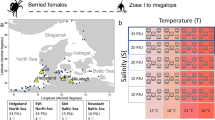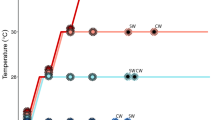Summary
Evidence for genetically determined life history variability within a population or a species is rare. In this three year experimental examination of a parthenogenetically reproducing population of the planktonic crustacean Daphnia parvula, we found evidence for a succession of clones or groups of clones that exhibited distinctive body size and reproductive differences that were maintained after numerous generations under standardized conditions in the laboratory. The D. parvula population reached maximum density in the fall and maintained relatively high densities through the winter and spring. Isolates from this fall-winter-spring period all had a larger body size at death and higher fecundity when compared with summer isolates under natural food and temperature conditions. These differences could not be accounted for by differences in temperature and food abundance among the seasons. An additional difference in these experiments was a shift in reproductive effort by the summer isolate which produced a higher proportion of its offspring in the first two broods. The shift in life history characteristics and a summer decline of the Daphnia parvula population was correlated with both an increase in inedible and perhaps toxic blue-green algae and an increase in a dipteran predator Chaoborus. Comparison of the survivorship curves for all of the seasonal life history experiments indicated that D. parvula survivorship was not lower during the summer discounting a toxic effect from blue-green algae. Positive population growth on natural food in the laboratory at this time indicated food was not limiting and that predation was the probable cause of the population decline.
Laboratory life history experiments under standardized food and temperature conditions were run with D. parvula isolates from the spring and summer plankton. Genetically based differences as determined in these experiments were smaller body size, lower fecundity, smaller brood size, and shorter life span for the summer animals relative to spring animals. Thirty seven percent of the summer animals also reproduced at an earlier age under standardized conditions. The shift in reproductive effort to earlier broods by summer animals rnder natural conditions appeared to be a phenotypic response as the summer isolate did not produce a higher proportion of its offspring in early broods under standardized conditions.
When estimates of predatory mortality were added to the life tables of the standardized experiments, the earlier reproduction of some of the summer animals allowed a population increase under a regime of intense predation. Life tables for the spring animals predicted a population decline under these circumstances. Predictable seasonal changes in biotic factors such as predation suggest a mechanism whereby diverse life history patterns with corresponding differences in r may be maintained within a population.
Similar content being viewed by others
References
Bell G (1980) The costs of reproduction and their consequences. Am Nat 116:45–76
Black RW (1980) The genetic component of cyclomorphosis in Bosmina. In: Kerfoot WC (ed) Evolution and ecology of zooplankton communities. University Press of New England, Hanover New Hampshire, pp 456–469
Brock DA (1980) Genetic succession in the cyclomorphosis of Bosmina longirostris (Cladocera). Freshwater Biol 10:239–250
Brooks JL (1957) The systematics of North American Daphnia. Mem Conn Acad Arts 13:p 180
Brooks JL (1967) Cyclomorphosis, turbulence, and overwintering in Daphnia. Int Ver Theor, Angew Limnol Vert 16:1653–1659
Caswell H, Hastings A (1980) Fecundity, development time, and population growth rate. An analytical solution. J Theor Pop Biol 17:71–79
Conover WJ (1980) Practical nonparametric statistics. Wiley New York
Hebert PDN (1974a) Enzyme variability in natural population of Daphnia magna II genotypic frequencies in permanent populations. Genetics 77:323–334
Hebert PDN (1974b) Enzyme variability in natural populations of Daphnia magna. III. Genotypic frequencies in intermittent populations. Genetics 77:335–341
Hebert PDN (1981) Obligate asexuality in Daphnia. Am Nat 117:784–789
Hebert PDN, Crease TJ (1980) Clonal coexistence in Daphnia pulex Leydis: another plankton paradox. Science 207:1363–1365
Kerfoot WC (1980) Perspetives on cyclomorphosis: separation of phenotypes and genotypes. In: Kerfoot WC (ed) Evolution and ecology of zooplankton communities. University Press of New England, Hanover New Hampshire, pp 470–496
King CW (1980) The genetic structure of zooplankton populations. In: Kerfoot WC (ed) Evolution and ecology of zooplankton communities. University Press of New England, Hanover New Hampshire, pp 315–328
Krueger DA, Dodson SI (1981) Embryological induction and predation ecology in Daphnia Pulex. Limnol Oceanogr 26:219–223
Lewontin RC (1965) Selection for colonizing ability. In: Baker HG and Stebbing GL (eds) The genetics of colonizing species. Academic Press, New York, pp 79–94
Loaring JM, Hebert PDN (1981) Ecological differences among clones of Daphnia pulex Leydig Oecologia (Berlin) 51:162–168
Lynch M (1983) Ecological genetics of Daphnia pulex. Evolution 37:358–374
Manning BJ, Kerfoot WC, Berger EM (1978) Phenotypes and genotypes in cladoceran populations. Evolution 32:365–374
Orcutt JD Jr (1982) Population dynamics, physiology, and the adaptive significance of diel vertical migration by zooplankton in Lake Oglethorpe, Georgia. Ph.D. Thesis. University of Georgia, Athens
Orcutt JD Jr, Porter KG (1983) Diel vertical migration by zooplankton: constant and fluctuating temperature effects on life history parameters of Daphnia. Limnol Oceanogr 28:720–730
Pace ML, Orcutt JD Jr (1981) The relative importance of protozoans, rotifers and crustaceans in a freshwater zooplankton community. Limnol Oceanogr 26:822–830
Pace ML, Porter KG, Feig YS (1983) Species and age specific differences in bacterial resource utilization by two co-occurring cladocerans. Ecology 64:
Pastorok RA (1980) Selection of prey by Chaoborus larvae: A review and new evidence for behavioral flexibility. In: Kerfoot WC (ed) Evolution and Ecology of Zooplankton Communities. University Press of New England, Hanover New Hampshire, pp 533–534
Pastorok RA (1981) Prey vulnerability and size selection by Chaoborus larvae. Ecology 62:1311–1324
Porter KG, Orcutt JD Jr (1980) Nutritional adequacy, manageability, and toxicity as factors that determine the food quality of green and blue-green algae for Daphnia. In: Kerfoot WC (ed) Evolution and ecology of zooplankton communities. University Press of New England, Hanover New Hampshire, pp 268–281
Porter KG, Gerritsen J, Orcutt JD Jr (1982) The effect of food concentration on swimming patterns, feeding behavior, ingestion assimilation, and respiration by Daphnia. Limnol Oceanogr 27:935–949
Porter KG, Orcutt JD Jr, Gerritsen J (1983) Functional response and fitness in a generalist filter feeder, Daphnia magna (Cladocera: Crustacea). Ecology 64:735–742
Stearns SC (1976) Life-history tactics: a review of the ideas. Quar Rev Biol 51:3–47
Stearns SC (1980) A new view of life-history evolution. Oikos 35:266–281
Snell TW (1980) Blue-green algae and selection in rotifer populations. Oecologia (Berlin) 46:343–346
Snell TW, King CE (1977) Lifespan and fecundity patterns in rotifers: the cost of reproduction. Evolution 31:882–890
Taylor BE (1980) Size-selective predation on zooplankton. In: Kerfoot WC (ed) Evolution and ecology of zooplankton communities. University Press of New England Hanover New Hampshire, pp 377–387
Tessier AJ, Goulden CE (1982) Estimating food limitation in cladoceran populations. Limnol Oceanogr 27:707–717
Young JPW (1979a) Enzyme polymorphism and cyclical parthenogenesis in Daphnia magma. I. Selection and clonal diversity. Genetics 92:953–970
Young JPW (1979b) Enzyme polymorphism and cyclical parthenogenesis in Daphnia magna. II. Evidence of heterosis. Genetics 92:971–982
Young JPW (1984) The population structure of cyclic parthenogens. In: Adaptation and taxonomic significance of protein variation. Academic Press, New York (in press)
Author information
Authors and Affiliations
Rights and permissions
About this article
Cite this article
Pace, M.L., Porter, K. & Feig, Y.S. Life history variation within a parthenogenetic population of Daphnia parvula (Crustacea: Cladocera). Oecologia 63, 43–51 (1984). https://doi.org/10.1007/BF00379783
Received:
Issue Date:
DOI: https://doi.org/10.1007/BF00379783




